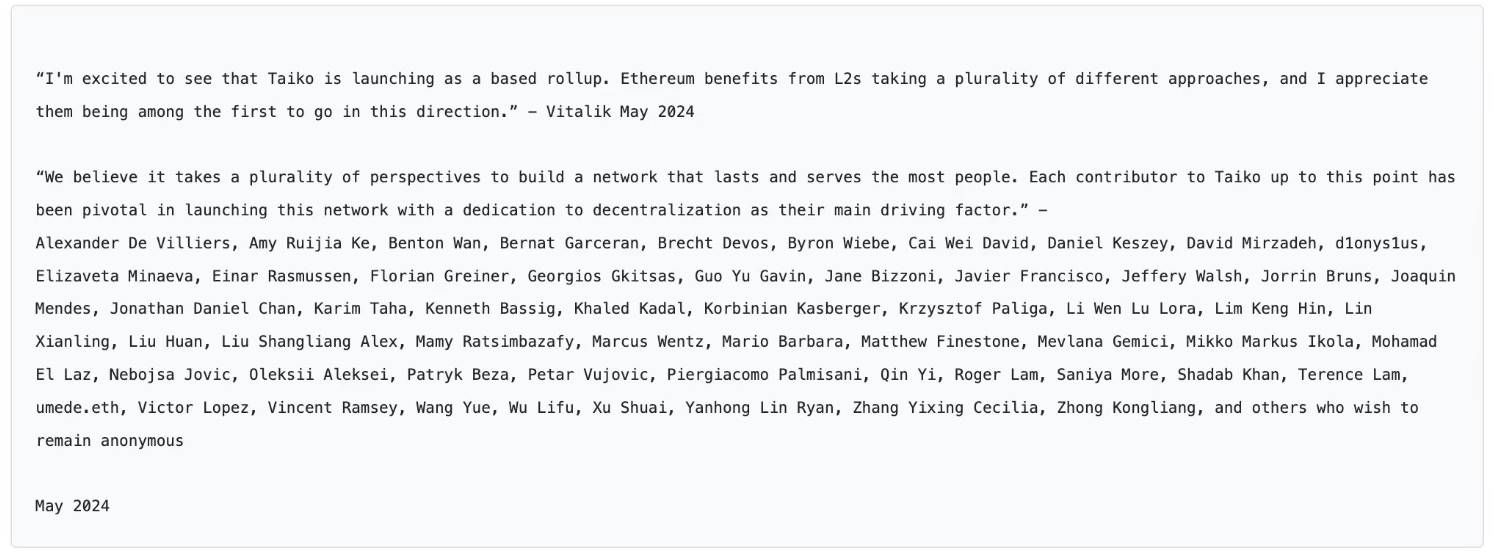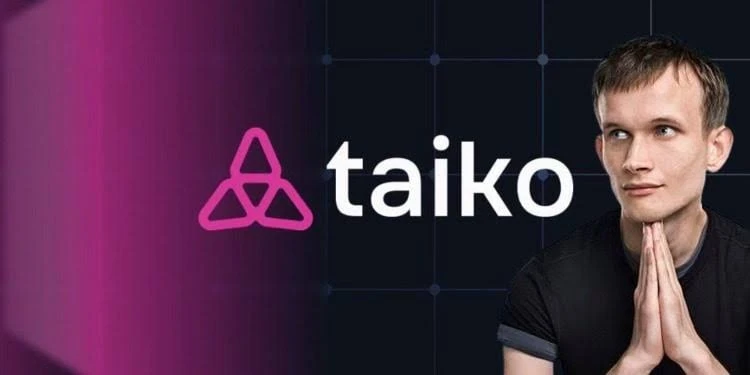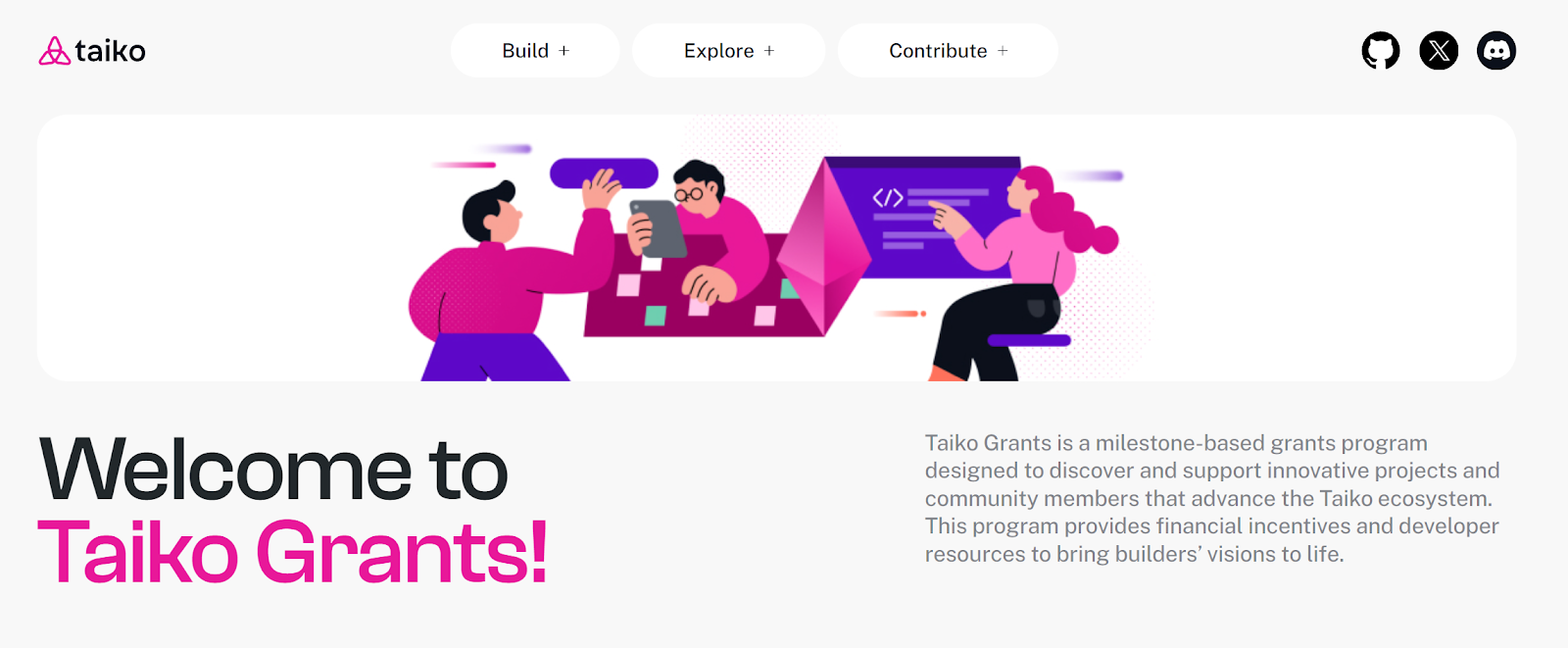Vitaliks new article praised Taikos technical innovation and ecological construction
With the return of the bull market and the approval of the Ethereum ETF, the Ethereum ecosystem has become popular. Among them, the L2 project Taiko has attracted great attention and discussion in the market recently. After Vitalik packaged Taikos first block and attached a message praising its technical route, Vitaliks article Layer 2s as cultural extensions of Ethereum published today mentioned Taiko again and said:
Each Ethereum L2 has its own unique soul. Taiko emphasizes seamless user experience, community-oriented, security first and Based (multi-dimensionally based on Ethereum).
In many previous large-scale events, Vitalik has repeatedly shared his views on the development of Ethereum L2, including that ZK is the future of Ethereum and that Ethereum L2 needs Multi-proofs from a longer-term perspective. Taiko, which has frequently received Vitaliks praise, is one of the first projects to put it into practice:
As a Type-1 zkVM, it is not only the first team in the industry to develop Based Rollup, but also the first project to implement the concept of Multi-proofs. It is committed to further improving the security and robustness of the system while supporting efficient and low-cost processing of complex calculations and large-scale transactions.
Outstanding technical strength and innovation capabilities not only make Taiko the pioneer of innovation in the Ethereum L2 track in the eyes of many people, but also make the community have high expectations for the Taiko mainnet airdrop: On May 27, 2024, the Taiko mainnet was officially launched. At this milestone moment of the project, Vitalik, as always, sent his support and blessings, and packaged a header block with a height of 1 on the network. Its metadata contains the name of each Taiko core contributor, and expressed his expectations for the launch of the Taiko mainnet and thanked the team for their key support in realizing decentralized community-led and promoting network launch.
As the mainnet goes online, Taikos other important milestone token TGE also enters the countdown stage.
This article aims to get to know Taiko, explore the core advantages and ecological construction strategies of the project from a technical perspective, and get to know Taikos vision of building a truly decentralized, permissionless, efficient and low-threshold L2 architecture that fully inherits the security features of Ethereum.
Taiko frequently receives praise from Vitalik Buterin: Multiple technological innovations have achieved true decentralization
In the fiercely competitive L2 track, Taiko has been able to carve out a place for itself in the homogeneous competition. Many peoples first impression of Taiko comes from its star entrepreneurial team on the one hand and the projects outstanding technological innovation capabilities on the other.
As we all know, the core team of Taiko is almost the original team of Ethereum L2 ZK-Rollup project Loopring, which is the first ZK-Rollup deployed on Ethereum. In 2020, Loopring was listed on Coinbase, becoming the first Chinese project to be listed on Coinbase. Daniel Wang, co-founder and CEO of Taiko, was not only the founder of Loopring, but also has rich experience in Web2. He has served as the technical director of JD.com, the technical director and senior software engineer of Google, and other important positions. With the dual experience of Web2 + Web3, Taiko has attracted much attention since its birth. The project has a solid technical foundation from product design to specific implementation.
From a technical architecture perspective, Taiko is divided into three main modules:
-
Multi-Prover: Utilizes multiple integrated proof systems such as zkVM and SGX to directly compile and run the Rust-based Ethereum virtual machine to generate zero-knowledge or TEE proofs to verify the accuracy and integrity of Ethereum block execution. With Multi-Prover, Taiko can expand Ethereum without changing existing smart contracts and dApps, while inheriting Ethereums security, decentralization, and compatibility.
-
Layer 2 Rollup Node: Responsible for managing and executing transactions on Layer 2 while interacting with Ethereum Layer 1 (L1). Through Layer 2 Rollup technology, Taiko is able to increase Ethereums transaction throughput, reduce transaction costs, and maintain decentralization and security.
-
Taiko Protocol: Defines and executes the rules of Layer 2 Rollup to ensure the correctness of transactions and the security of the network. Through smart contracts and decentralized verification, the Taiko Protocol achieves efficient expansion of Ethereum while maintaining its decentralization and security features.
Taiko aims to be a Type-1 zkVM: As a general computing platform based on ZKP, zkVM can verify the correctness of calculations without revealing execution details. It also supports processing tasks with large computational workloads outside the chain, and only submits the verification results to the blockchain, which greatly improves the scalability of the blockchain. In addition, compared with other solutions, Type-1 zkVM is completely equivalent to Ethereum and is an EVM that can run directly on the Ethereum chain, but there is a high technical threshold. Therefore, there are not many projects in the industry that pursue the implementation of Type-1 zkVM, and Taiko is one of them. Based on Taiko, developers and users can experience Ethereum safely, with lower transaction fees, and without making any changes to Ethereum.
The BCR architecture built on Multi-proofs further expands Taikos advantages in cost, efficiency and security.
As a key innovation of the Taiko protocol, the core of the BCR framework (Based Contestable Rollup) lies in competition: anyone can become a proposer and submit a block proposal, and any validator who disagrees with the state transition result can submit a security level challenge proof, change the L2 block state, and choose between correct and incorrect forks. The proposer needs to package user transactions and generate zero-knowledge proofs, and multiple proposers can compete to submit blocks at the same time; the validator is responsible for verifying the blocks and zero-knowledge proofs submitted by the proposer, and multiple validators can compete to verify blocks. This process not only ensures the decentralization of the generation and submission process of each block, but also further increases the security of the network.
Multi-proofs is the core concept of implementing the BCR framework. The concept was first proposed by Vitalik and is regarded as an important direction for future Ethereum upgrades. Vitalik believes that the single-proof solution cannot cope with the bugs hidden in the complex code of zkEVM. Multi-proofs generates multiple proof types for a single block. Even if one type of proof has a problem, other types of proofs can continue to ensure the normal operation of the system and detect any erroneous state transitions in a timely manner.
As the first project to implement the concept of Multi-proofs, Taiko believes that multi-proof in ZK can be transformed into the use of multi-SNARKs + multi-Client, that is, using multiple ZK-SNARKs to prove multiple different Ethereum nodes, which will lay the foundation for the diversity of SNARKed nodes in Ethereum L1 in the future. In addition, Taiko also adopts the Halo 2-KZG proof system, which enables efficient and low-cost processing of complex calculations and large-scale transactions. Currently, Taiko has launched the multi-proofer Raiko, an integrated environment that can build, run and benchmark ZK-VM targets. It currently supports SP 1, Risc 0 and SGX, and is working to integrate Jolt and Powdr.
In addition, at the Multi-proofs for rollups Twitter Space event held on December 13, 2023, Vitalik also had an in-depth discussion and expressed high appreciation for Taikos other core innovation BBR (Based Booster Rollup).
Before understanding BBR, lets take a brief look at Based Rollup: Based Rollup, also known as L1-sequenced Rollup, was first proposed by Justin Drake, a researcher at the Ethereum Foundation in March 2023. It is a Rollup whose sorting is completely driven by the basic L1. This design outsources the sorting rights to L1 validators. The consensus layer, data availability layer, and settlement layer are all Ethereum. Only the execution layer is built on the Rollup network. This design does not require additional security mechanisms or consensus algorithms to ensure the validity and order of transactions. It not only simplifies technical complexity, reduces latency and operating costs, but also allows Taiko to fully inherit the security and decentralization of Ethereum, making it a more attractive L2 choice.
The birth of the BBR concept stems from the Taiko teams further thinking about Based Rollup: adding out-of-the-box native Ethereum L1 DApp extension functions to Based Rollup to further enhance the advantages. BBR not only integrates seamlessly with L1, but is also fully compatible with Ethereums existing architecture. It can enhance any type of aggregation, and its two-layer structure realizes the separation of transaction execution and storage, taking into account efficiency while ensuring decentralization. This solution, which is very close to native Ethereum expansion, improves transaction execution and storage efficiency. DApp only needs to be deployed once to automatically expand it to all L2s. If additional block space is required, more booster rollups can be added without any additional setup work.
Compared with other OP or ZK-based L2 projects, Taikos series of technological innovations also bring a unique and good experience to ecosystem participants.
The permissionless nature of Taiko is that anyone can generate a block or prove a block, and anyone has the opportunity to participate in the construction of the network.
Based Rollup, which outsources the sorting rights to L1 validators, not only makes Taiko a Layer 2 that truly inherits Ethereums decentralized will, but the design that allows anyone to become a proposer is more attractive for broad participation, further improving the systems decentralization and promoting a healthier operation of the network.
For developers, Taiko expands Ethereum at the technical and protocol layers through the operation mode of Ethereum itself, which is not only more secure and efficient, but also can achieve unlimited expansion with a single deployment, saving time and labor costs while lowering transaction fees and enhancing scalability.
It can be said that since its establishment, Taiko has never stopped thinking about L2 and pursuing innovation. From Multi-proofs, Based Rollup to BBR, Type-1 zkVM and other designs, Taiko is an active explorer of the L2 track in multiple dimensions. This has also attracted investments from a number of top industry institutions:
In March 2024, Taiko announced that it had received US$15 million in Series A financing. Together with the US$22 million raised in the previous two rounds of financing, Taikos cumulative financing amount has reached US$37 million. Participating institutions include Sequoia China, Generative Ventures, Lightspeed Faction, Hashed, Generative Ventures, Token Bay Capital, Ethereum Foundation, etc.
Taiko has always been committed to in-depth thinking and continuous innovation of the second-layer network (L2). With the acceleration of the mainnet launch and ecological construction process, Taiko, on the one hand, seeks cooperation with many industry-leading projects, and on the other hand, attaches importance to mobilizing the enthusiasm of community participation and cohesion building, further enhancing the diversity and vitality of its ecology.
Ecosystem expansion continues, token TGE is coming soon
Taiko in May can be said to have firmly attracted the attention of the community.
The first is the widespread attention brought by the launch of the mainnet. Taiko has started testnet-related work since its development in 2022, and has more than 1.1 million independent wallets, more than 30,000 decentralized proposers and more than 14,000 decentralized validators during the testnet stage. After 7 testnets in two years, Taiko finally officially launched its mainnet on May 27.
It is also worth mentioning that after the mainnet is launched, the Taiko token is expected to be launched a few weeks after the mainnet is launched. Compared with the TVL and market value data of other leading L2s, Taiko, which has advantages such as multiple technological innovations, support from well-known institutions, and high praise from Vitalik, is considered by many people to have great potential in the Ethereum L2 track.
On May 23, before the mainnet launch, Taiko鈥檚 Genesis airdrop event was widely discussed in the community.
According to the token economics model released by Taiko, the total supply of TAIKO tokens is 1 billion, of which 5% will be allocated to the Genesis airdrop, which will be given to block proposers, block certifiers, users interacting with the testnet, users participating in Galxe activities, and users who make Github contributions on eligible repositories. In addition, TAIKO airdrop claims will be made on the Taiko mainnet L2, and airdrop tokens will not be locked and will not have a vesting period.
Subsequently, Taiko launched an airdrop query page, and a group of users who posted airdrops soon appeared on social media. According to the off-market information provided by AEVO Premarket, the current price of TAIKO is around $5.
However, it is always difficult for large-scale airdrops to satisfy everyone. The Genesis Airdrop of Taiko generally showed a situation of some are happy while some are sad, and some users also posted articles to express their dissatisfaction.
In response to community sentiment, the Taiko team updated its official FAQ. According to the latest update, there are 300,000 addresses that have claimed more than 50 million tokens in the airdrop. Then, as one of the recipients of this airdrop, Loopring announced that it would distribute the 2.5 million TAIKO it received to the community.
In addition, this Taiko Genesis airdrop is only the first phase, accounting for 5% of the total token supply, and 10% of the tokens will be used for subsequent airdrops in the future. For example, in the Trailblazers event, it is reported that the event badge can enhance the pioneer points plan. Participate in the Trailblazers event and cast faction badges on the mainnet day to get exclusive rewards.
In terms of ecology, before the mainnet was launched, Taikos ecological construction had already taken shape.
According to data from Taiko鈥檚 official website, there are currently more than 100 projects that have entered the Taiko ecosystem, covering categories such as wallets, NFT markets, oracles, DeFi, AI applications, etc.
With the official launch of the mainnet and the acceleration of the ecological construction process, Taiko will attract more high-quality projects to settle in and officially announce cooperation in the near future, such as Pyth, Etherscan, Pancakeswap, Layer Zero, etc.
The rich ecosystem benefits from the low development threshold brought by Taikos technological advantages: as a Type-1 zkVM L2 solution, Ethereum dApps can be seamlessly migrated to the Taiko ecosystem, and most of the time developers dont even have to worry about deployment and code adjustments.
On the other hand, Taiko, which attaches great importance to ecological construction, also provides a series of ecological development support policies: developers can obtain a series of practical tools and tutorials by checking the regularly updated documents on the official website. In addition, Taiko has also launched an ecological funding program, which aims to explore the potential for ecological innovation and provide financial, operational, technical and other support to developers who are interested in building applications based on the Taiko ecosystem, further promoting the prosperity and development of the ecosystem.
In general, although the official launch of the mainnet is only the starting point for Taiko to embark on a new journey, the data performance in various dimensions after the mainnet launch still needs to be observed and verified, but for the Taiko project, multiple technological innovations, impressive financing and team background have injected inexhaustible impetus into the subsequent development of the project… The superposition of multiple advantages is also an important reason for more community members to keep paying attention to the project.
For crypto projects, technological innovation is the foundation of survival, and ecological construction is a key factor in whether the project can develop in the long term. Therefore, listening to the voice of the community, implementing effective incentives, and bringing participants a more transparent, rich and diverse ecological participation experience are important topics throughout the entire life cycle of the project. With the launch of the mainnet and the landing of multiple milestones, we expect innovative explorers like Taiko to continue to promote the upgrade and development of Ethereum L2.
This article is sourced from the internet: Vitaliks new article praised Taikos technical innovation and ecological construction
Original author: Wsen Original translation: Christine My Trading Journey As an experienced CS 2 skin trader on Steam, I have personally experienced the ups and downs of skin trading. My trading philosophy has always been to stay ahead of the trend and use opportunities brought by strategy and insight to obtain the highest returns. Here, people are not diving into profits, but pursuing community, strategy, and the thrill of the hunt. However, the recent downturn in the CS 2 market, coupled with the surge in the cryptocurrency space, prompted me to turn to an area I had been quietly observing before – Crypto GameFi. Transition to Crypto and GameFi The allure of cryptocurrency is undeniable. Although I am relatively familiar with the use of cryptocurrency to trade Steam assets, I…
















